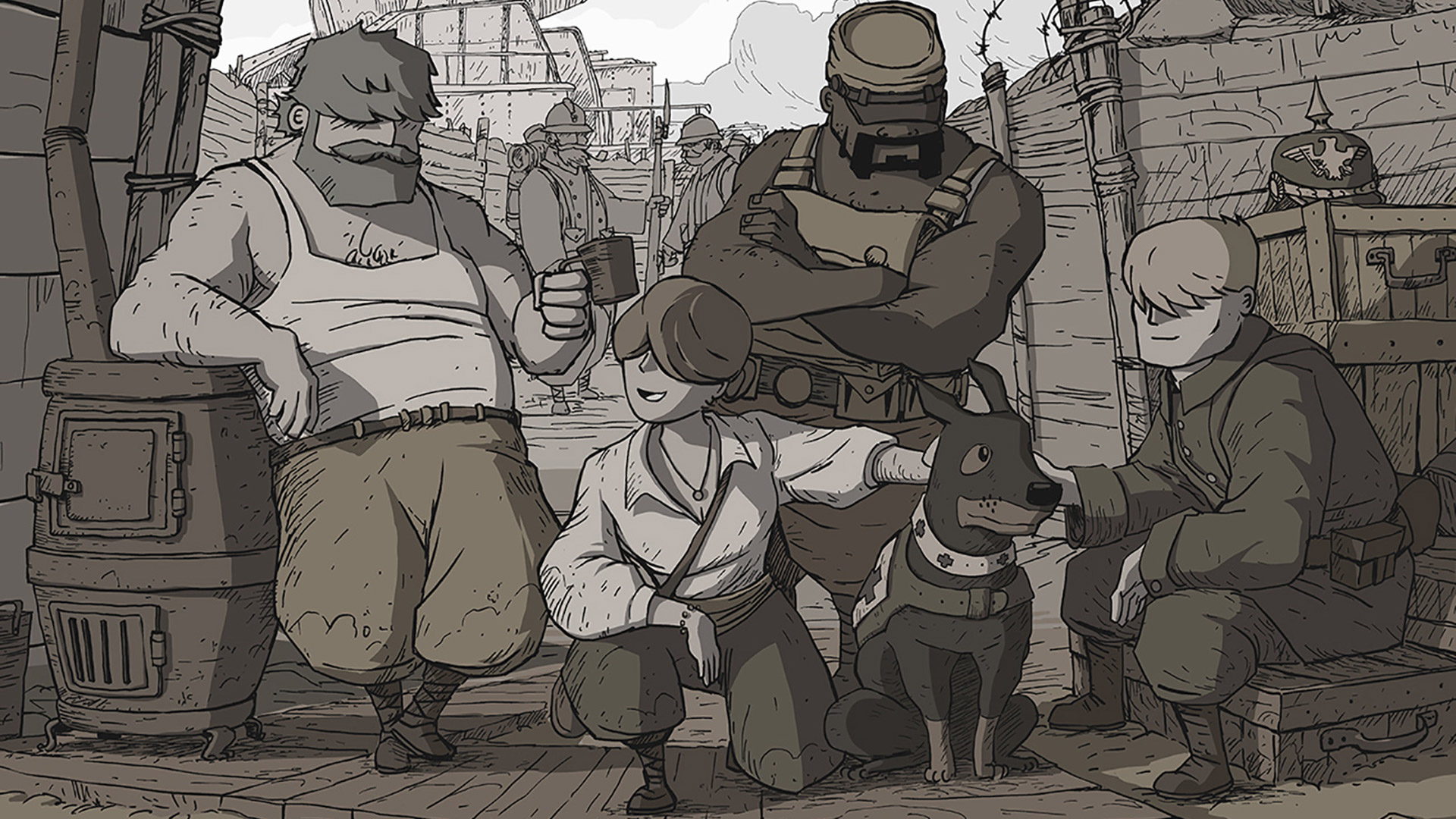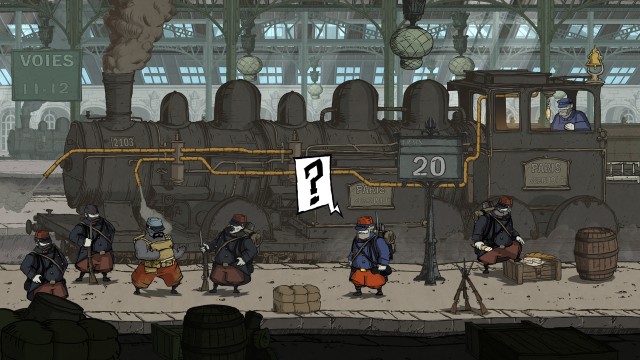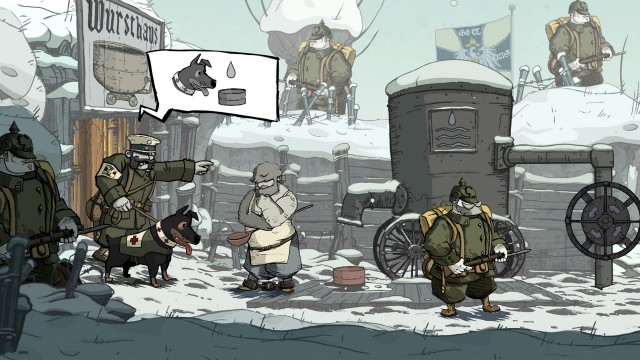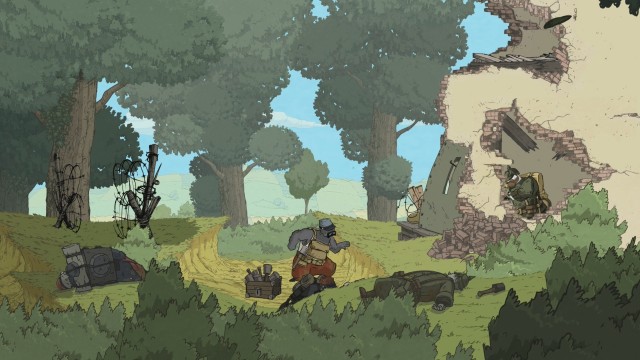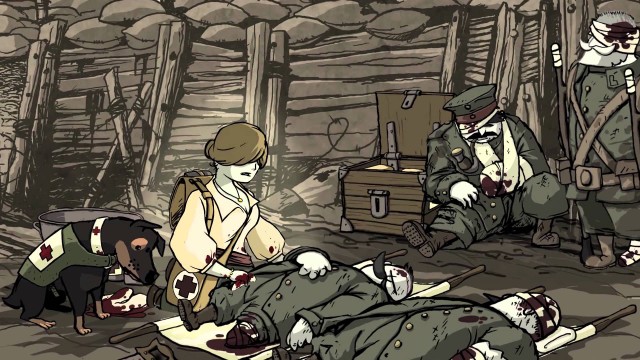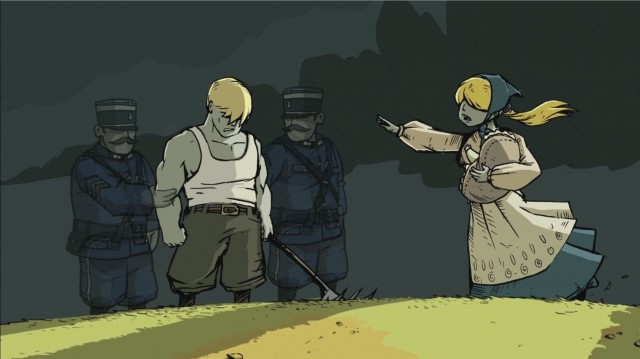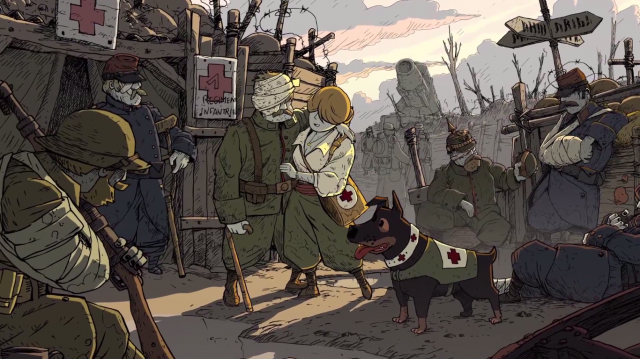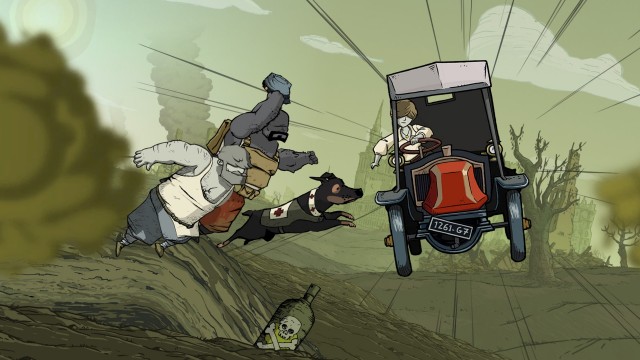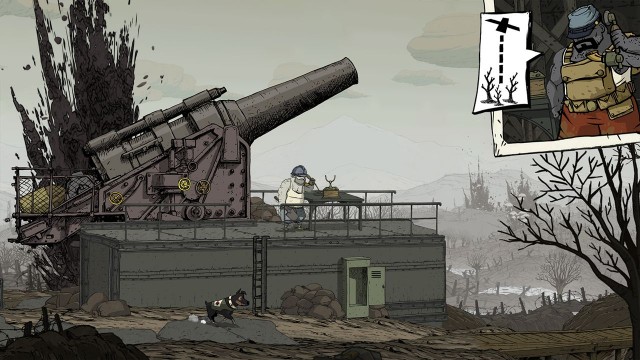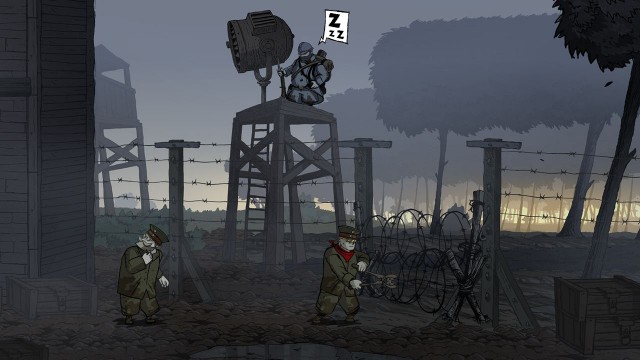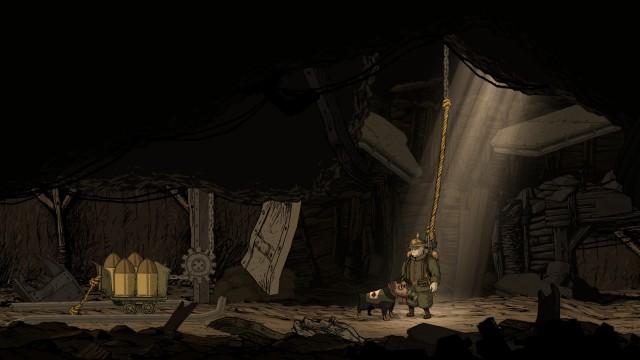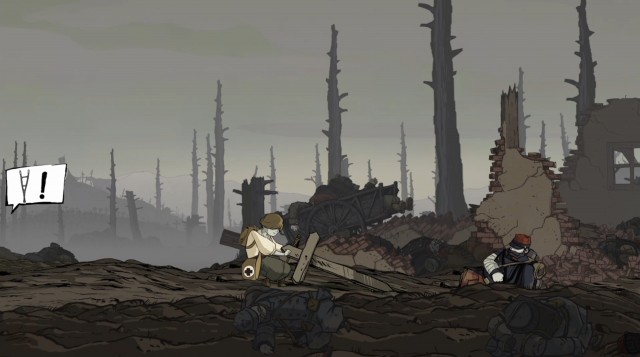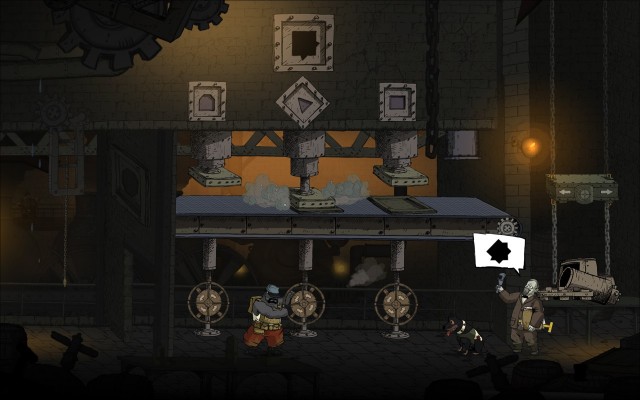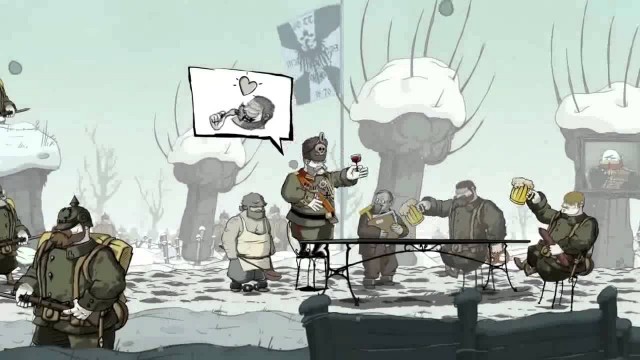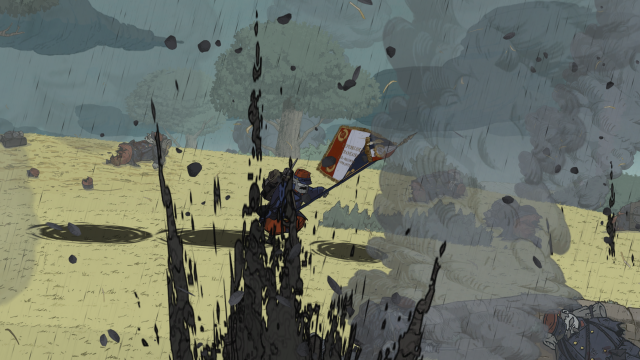NOTE: While our review of Valiant Hearts: The Great War primarily focuses on the original console and PC releases of the game, we’ve added an additional section before the final verdict to address the belated mobile port of the game on iOS and Android.
Video games and war generally have a little understanding with each other. Video games will present an action-packed, distilled version of any given conflict, whether it be WWII or contemporary warfare or whatever else, thus removing proceedings far enough from reality so that they don’t disrespect any of humanity’s darker moments.
But then, you get Ubisoft’s recent intriguing experiment with their UbiArt Framework engine, Valiant Hearts: The Great War, which dares to challenge the relationship between video games and war. Shifting the focus to WWI, a rarely explored battle in the video game medium, and making the fighting itself a backdrop rather than a focus, the game attempts to highlight the struggle of a group of survivors, instead of the demand to shoot up legions of bad guys.
It’s an interesting and bold experiment, though not one without a few issues. The game is definitely outclassed by this year’s other excellent UbiArt Framework offering, Child of Light, and the attempt to be simultaneously heart-wrenching and colourful does occasionally lead to some confused, mis-matched game design.
To those looking for a great storyline though, and particularly an emotional one, Valiant Hearts: The Great War is still worth checking out, especially when you consider how effectively it stands apart as a war-themed video game.
Being powered by UbiArt Framework, even the last-gen builds of Valiant Hearts: The Great War are very well-realized at native 1080p. This is the one strength that this game does have over Child of Light— It doesn’t inexplicably cap its Xbox 360 and PS3 versions at 720p, when the engine is blatantly capable of something better with minimal effort.
In fact, if anything, the game may be a little too well-realized for last-gen consoles, since there’s literally no discernable difference between Xbox 360 and PS3, and Xbox One and PS4, at least in terms of the graphics. Even the PC version doesn’t venture anywhere beyond its console counterparts, being perhaps a mite more sharply-drawn when run on optimal settings.
On any of the five platforms hosting Valiant Hearts: The Great War, the game also caps at 30fps, though this isn’t really an issue. It’s not a fast-paced game by any stretch, and is more about creating an experience than creating action.
Fortunately, Valiant Hearts: The Great War still does an excellent job at realizing said experience. The stylized, almost graphic novel-esque sequences work surprisingly well in telling a story about such a dark time for humanity. Likewise, the characters are endearingly drawn, with their eyes cutely obscured by their hair or hats, leaving their expressions and gibberish talk to realize any emotion.
As much as the game is clearly rendered as a cartoon, Valiant Hearts: The Great War still successfully proves that UbiArt Framework isn’t necessarily limited to upbeat, happy stories. The engine still works in a game that is drearier and more dramatic, using the chipper art style to better convey a sense of endearment and tragedy, leading to gamers sympathizing with characters in several respects that, frankly, work better than if the game was done in a realistic, live-action style.
The visuals may service the narrative well, but even then, Valiant Hearts: The Great War is an attractive game that is full of distinct environments and memorable stage backdrops, which is no small feat for a war mostly fought underground! The graphics are definitely inkier and more subdued than the bright, shining visual style of Child of Light, but the other extreme still wonderfully flexes one of the industry’s best and most interesting game engines quite remarkably!
Valiant Hearts: The Great War has a very soft-spoken soundtrack, particularly in the menus, which are accompanied by a soft piano melody. The piano-heavy soundtrack is one thing that definitely does echo Child of Light, but this game still has its own composition style, and still effectively combines quiet optimism with sombre reverence.
Occasionally, there are swells of orchestra, as one would expect from a game about war, but even these are done without the flair of a blockbuster action spectacle. The game is definitely a drama, and plays its tunes to keep emotion high, rather than adrenaline. The only time it doesn’t work is during the handful of moments where Valiant Hearts: The Great War tries harder to be a video game, such as when it has to crowbar in an awkward boss fight, or otherwise interrupt the story with some ludicrous sequence that no doubt didn’t happen during the actual events of WWI.
Fortunately, even the shakier moments don’t break the experience fully, since the sound effects are not done with any air of realism. They have the same exaggerated, cartoonish flavour as the visuals, with the violence carrying enough power to feel real, but never to the point where it disturbs the beauty of the overarching game.
Valiant Hearts: The Great War is also mostly devoid of voice acting, beyond the reverent delivery of a narrator, and an occasional British voiceover for one of the game’s lead characters, Emile. Why Emile, a French character, is voiced with a blatantly English accent is pretty unclear, but that’s a minor nitpick.
Most of the time however, characters only speak in gibberish, with the odd short sentence being spoken in actual English, French or German, and even then, never more than about three words. It’s another element of the game that might initially seem too cute for a game detailing such dark subject matter, but it works far better than it should, giving the characters a sense of innocence and whimsy that further hammers home the devastating stakes of the so-called Great War.
Like any other UbiArt Framework game to date, Valiant Hearts: The Great War is as lovely to listen to as it is to watch, even if it no doubt views its historical events through a colourful kaleidoscope.
Valiant Hearts: The Great War unfolds from the perspectives of four lead characters: Emile, an older French farmer from St. Mihiel, who is conscripted to fight in The Great War for his country; Karl, a German citizen living in France who is deported and separated from his wife (Emile’s daughter) and child, then drafted into the German army; Freddie, an American soldier of fortune volunteering for the French army, with a vendetta against German officer, Baron Von Dorf for the death of the woman he loves; And lastly, Anna, a Belgian woman working as a battlefield nurse, so she can also track Baron Von Dorf, in this case to rescue her scientist father that is being forced to build war weapons for Germany.
Despite Ubisoft claiming that Valiant Hearts: The Great War is inspired by actual letters written by actual people during WWI, and certainly doing their homework with several credible sources regarding WWI facts, it’s clear from the get-go that much of the game is fictionalized and romanticized. The war itself is not neutered, with plenty of harrowing and disturbing sequences of violence and carnage throughout even this colourful, cartoony game, but Valiant Hearts: The Great War is still forced to concede that it’s a video game more often than not.
How does one play it though? Well, Valiant Hearts: The Great War is best described as a puzzle-adventure game. The game is divided into four chapters, freely shifting between the perspectives of its four leads, who occasionally intersect and interact with one another. Giving a scattershot telling of WWI as it unfolds between 1914 and 1917 (the end of the war in 1918 is not covered), players see the war through multiple viewpoints, experiencing the horrors of The Great War from a variety of angles.
It’s clear that Ubisoft wishes to court casual gamers as well, since Valiant Hearts: The Great War is almost never complex. Even without actual voice acting, the characters use actions and thought bubbles to convey simplistic information to the player, with most of the game consisting of straightforward objectives; Move here, rescue this person, place this object, aim this cannon, etc..
In fact, a rather bold omission from Valiant Hearts: The Great War is the fact that characters never actually aim or shoot a gun, if you don’t count directing artillery or manning a tank. It was previously believed that a war video game where the player can’t use guns would be a dull, redundant experience, but Valiant Hearts: The Great War proves, for better or for worse, that not every war game needs to give the player an arsenal.
There are still plenty of object puzzles however, with players throwing bricks to dislodge ladders and paths, or combining this and that to build an impromptu lever or gear. None of them are terribly complex either. Even the puzzles that incorporate Walt, a dog companion that is often at the disposal of the four lead player characters, are never difficult to understand or figure out, particularly with the ease of directing Walt by holding a shoulder button and then simply using the face buttons to get him to enter a tunnel, pull a lever, dig up an object, or whatever else.
Even if you do get stumped at any given point, Valiant Hearts: The Great War features a hint system, automatically unlocking up to three hints when a certain amount of time passes while the player has not successfully solved a puzzle. They illustrate objects of importance, and eventually virtually spoonfeed you the solution. Unless you hopelessly struggle with the basic fundamentals of playing any video game, Valiant Hearts: The Great War should never simply render you stuck.
If you’re a more hardened gamer hoping for at least some semblance of challenge, there are a whopping 100 collectibles to track down throughout the game at the very least. Each of them presents a WWI fact, and are based on actual WWI tools, texts and so forth. Beyond that, they simply exist for completion’s sake, and to award you achievements/trophies.
For those willing to appreciate the educational factor, Valiant Hearts: The Great War is actually impeccable for teaching players about the historical event that’s taking place, another stumbling block that trips up just about any period shooter ever made to date. Each stage is complemented by photo snippets with information about the real-life history behind whichever setting the player is currently in, along with diary entries from the lead characters expressing further insight into them. This is all purely optional, but it’s great that those actually interested in learning about WWI as they play can do so in a friendly and easy manner.
The gameplay itself however tends to range in quality. There are some sequences that finely balance fun and fact, such as a challenge to dodge obstacles in a car while fleeing military police, or running through a gas-filled farm trying to open paths and rescue people. Others however don’t work quite as well.
Chief among these are the somewhat forced boss encounters, which feel out of place in a game that’s trying to be a reverent, emotional tale set amidst a real historical conflict. Trying to use a church organ to fight a zeppelin for example feels like it belongs in an entirely different game. Likewise, a cheesy fight with a German war machine is the only point where Valiant Hearts: The Great War slips up as an effective war drama, and then indeed starts feeling like a cheesy action game.
For the most part however, even if it’s not really a challenging game, the puzzles mostly feel organic and clever, and the experience is nicely polished. Each stage feels clearly distinct, with their own memorable set of obstacles, and you’ll never get the sense that anything just feels like mindless busy work, particularly thanks to the smartly-placed collectibles.
Between the five platforms, there aren’t any real gameplay differences to speak of. The PS4 version lets you aim objects and pet Walt using the controller’s touch pad, but that doesn’t really add anything to gameplay. Likewise, you have the option of using a mouse and keyboard or a gamepad when playing the PC version, with either option being serviceable. Most players will likely opt to use a gamepad however, since Valiant Hearts: The Great War seems to be designed primarily with consoles in mind.
PC gamers should also be aware that Valiant Hearts: The Great War isn’t realized as well on PC as Child of Light was earlier in the year. The PC version of Valiant Hearts: The Great War has a handful of unique visual and technical bugs that aren’t present in the console versions, and while several have been patched out, a handful still remain.
Likewise, the PC version of the game, as with any Ubisoft game on PC, forces you to go through the annoying UPlay DRM authentication to even start it up. PC gamers are no doubt used to that at this point, but it’s still another irritating hoop to jump through on PC that isn’t present on consoles.
All in all though, Valiant Hearts: The Great War is a consistently interesting, mostly good gameplay experience. There isn’t much replay incentive once you finish it up, amass all of the collectibles, and attain every achievement/trophy, but while it lasts, it effectively challenges the paradigm of war games, while presenting the argument that war games can be both effectively dramatic and effectively educational in the right hands.
Valiant Hearts: The Great War seems to drift in and out of an actual effort to be based on real historical fact, effective player education mechanics notwithstanding, but the fundamental story behind the game is still good.
As with the actual WWI, the game begins in 1914, with the assassination of Archduke Franz Ferdinand, leading to Germany declaring war on Russia, and sowing the seeds for a global conflict. With France preparing for war and deporting all of its German citizens, a man, Karl, is separated from his wife and son, eventually being drafted for the war, alongside Karl’s father-in-law, Emile.
From there, Emile meets and befriends an American, Freddie, who is volunteering in the French army to get revenge on one of its officers, Baron Von Dorf. Emile and Freddie watch out for each other in battle as Karl is forced to serve under Von Dorf. All the while, a Belgian nurse, Anna, seeks Von Dorf for her own agenda, to liberate her father, who is being forced to develop Germany’s war machines. Amidst all this, a ‘dog of war’, Walt, proves a steadfast companion to all of these people.
From there, Valiant Hearts: The Great War tells the story of these characters surviving and progressing through the backdrop of WWI. Twists and turns inevitably take place, and some are done pretty well to boot. There’s a few too many obvious death fake-outs, where player characters appear dead, but are obviously alive, and that’s the one thing dragging down an otherwise poignant and evocative ensemble tale.
Regardless, Valiant Hearts: The Great War builds up to a strong climax and an especially heart-wrenching ending, even if it doesn’t detail the ending portions of the actual war. Even during its weaker moments, it’s a story that effectively tugs at the heartstrings throughout most of its duration, and its fine balance of colourful optimism and sudden tragedy effectively engage players’ emotions on a consistent basis.
Bottom line, it amounts to easily one of the most effectively dramatic and emotional storylines in any war-themed video game to date. Maybe that’s a low bar, given that many war-themed video games are all about the action, and often stumble with actual character development and emotional stakes.
Still, it’s nice to see that Valiant Hearts: The Great War effectively demonstrates that good, human-focused storytelling is certainly possible in a war-themed video game, particularly in how well it challenges players to look at global conflict from a different angle than they otherwise would.
A couple of months after its initial release for consoles and PC, Valiant Hearts: The Great War was made available on the App Store and Google Play Store for recent models of iDevices and Android devices. This version of the game is fundamentally identical in terms of progression and gameplay to the previous console/PC release, though it is now split into three episodes, which can be purchased together for $11.99, or bought individually for $4.99.
The episodic format, along with the new touch interface, make Valiant Hearts: The Great War feel more like a point-and-click adventure game on smartphones and tablets. This tweak suits the game well, but as you may expect, using the touch controls is less precise and more finnicky than playing with buttons and sticks, or a mouse and keyboard in the previous releases. It’s not a deal killer, but it is a continual nuisance in a game that otherwise benefits from portability, and a touch format.
Still, this is the same effective emotional piece on mobile as it is on consoles and PC. It’s noticeably more comfortable and sharp to play on a tablet compared to a smartphone, where it feels a little too cramped and occasionally blurry (especially when the camera zooms in), but if you enjoy evocative adventure gaming on your mobile device, Valiant Hearts: The Great War is worth the download.
Valiant Hearts: The Great War is sadly the weakest UbiArt Framework offering that Ubisoft has delivered to date, but reaching the immense standard of the superb Rayman Origins, Rayman Legends and Child of Light would certainly be no small feat for a game. Even being the runt of the litter so far, Valiant Hearts: The Great War is still a good game, and an experimental idea that is certainly worthy of applause due to the sheer virtue of it existing.
For $14.99, the price is right if you’re a gamer that wants to experience an emotional and memorable story, at the very least. Valiant Hearts: The Great War mainly sells itself on story and drama, since the gameplay is mostly unchallenging and there’s no reason to revisit the game after you’ve scooped up all of its goodies and rewards. Even then, it falls well shy of, say, the narrative-driven adventure games of Telltale, or even last year’s wonderfully emotional indie standouts, such as Brothers: A Tale of Two Sons or Gone Home.
If you want another game along those lines however, Valiant Hearts: The Great War still does enough to satisfy. You can’t go wrong on any of its platforms, particularly since there’s no discernable difference between its last-gen and next-gen versions, beyond the Xbox One version having achievements that are worth more Gamerpoints, adding up to a full 1,000 rather than the Xbox 360 version’s 400, and the PS4 version occasionally incorporating the touch pad. Remember as well that PC players will have to deal with UPlay, on top of a few technical bugs unique to that version.
In any case though, Valiant Hearts: The Great War is not perfect, and like any other attempt, it can’t fully capture the truly devastating scale of actually fighting in WWI. As an observation of the centennial for one of humanity’s worst conflicts however, it’s nonetheless beautiful and poignant, and effectively demonstrates that not all video games centered on war have to be about killing people.

